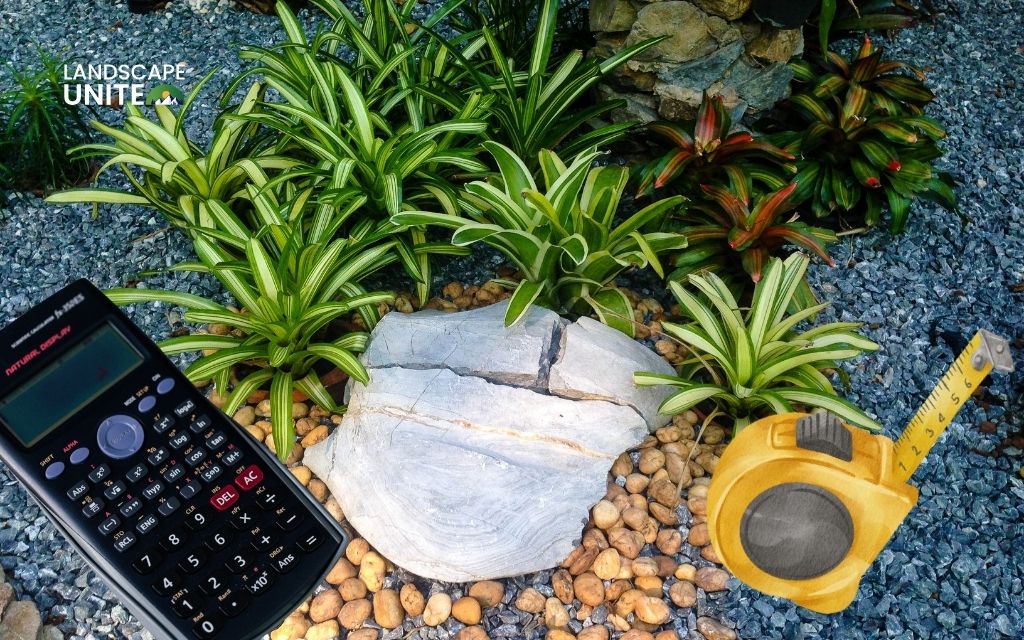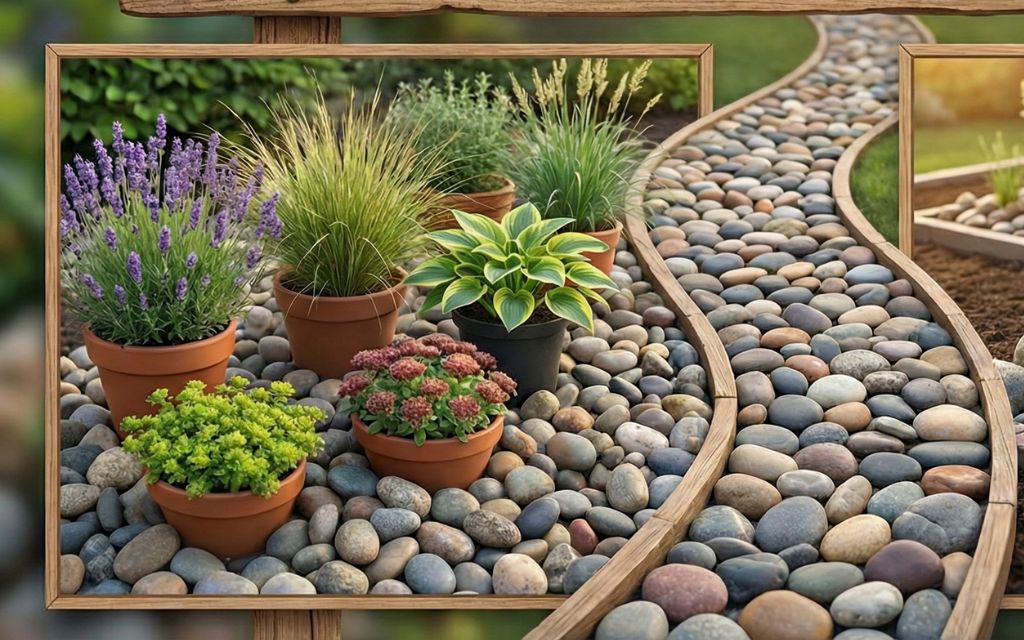Looking to create a water-wise garden that stays beautiful year-round? These drought-tolerant succulents are your answer to low-maintenance, sustainable landscaping that can reduce water usage by up to 75%.
From the architectural drama of towering Agave plants to the delicate rosettes of Echeveria, succulents offer an extensive palette of colors, textures, and growth habits. Popular genera like Aloe, Crassula, Sedum, Sempervivum, and Yucca provide options for every garden style and climate zone.
If you’re looking to create a low-maintenance xeriscaping garden that conserves water while maintaining year-round beauty, choosing the best succulents for xeriscaping is your gateway to success. Here are the top 10 best succulents for xeriscaping you can choose.
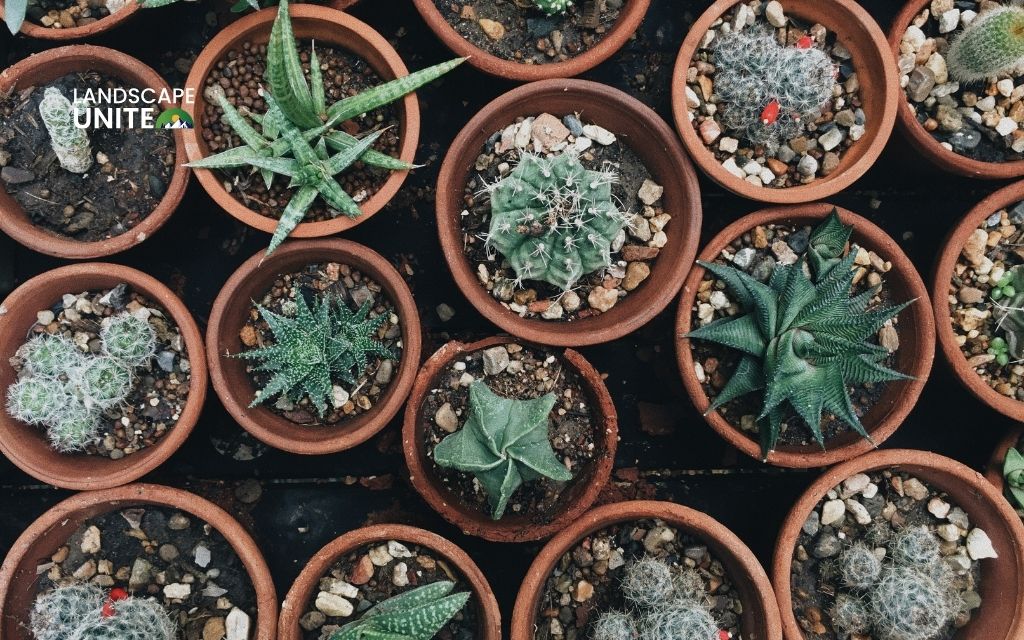
Top 10 best succulents for xeriscaping
Here are the 10 best succulents for your xeriscape garden, selected for their exceptional drought tolerance, visual impact, and adaptability to various landscape designs.
Agave
Agave plants are the architects of the succulent world, creating bold focal points with their sculptural rosettes and sword-like leaves. These powerhouse plants can survive on rainfall alone in most climates and actually prefer dry conditions to wet soil.
Best for: Statement plants, focal points in gardens, creating dramatic landscape anchors
Varieties to consider:
- Agave americana (Century Plant) – Large, blue-gray rosettes perfect for spacious landscapes
- Agave parryi (Parry’s Agave) – Compact, symmetrical form ideal for smaller spaces
| Pros | Cons |
| – Extremely drought-tolerant and low-maintenance – Architectural shape adds structure and symmetry to landscape designs | – Sharp leaf tips require careful placement away from high-traffic areas – Some species are monocarpic (die after flowering) |
Aloe Vera
Beyond its renowned medicinal properties, Aloe vera offers exceptional drought tolerance and requires virtually no maintenance once established. Its thick, gel-filled leaves store water efficiently, while its compact growth habit makes it versatile for various landscape applications.
Best for: Edging, containers, ground covers, and medicinal gardens
Varieties to consider:
- Aloe barbadensis (True Aloe) – The classic medicinal variety with healing gel
- Aloe striata (Coral Aloe) – Features stunning coral-pink leaf edges and compact growth
| Pros | Cons |
| – Easy to grow in containers or rock gardens – Provides natural healing gel for burns and skin care | – Sensitive to frost; best suited for warmer climates (zones 9-11) – Requires excellent drainage to prevent root rot |
Echeveria
These rosette-forming beauties bring vibrant colors and intricate patterns to xeriscape designs. Echeveria plants offer an incredible range of hues, from silvery-blue to deep purple, often with contrasting leaf edges that create stunning visual interest.
Best for: Borders, rock gardens, containers, and detailed landscape compositions
Varieties to consider:
- Echeveria elegans (Mexican Snowball) – Pale blue-green rosettes with pink flower spikes
- Echeveria imbricata (Blue Rose) – Larger rosettes with blue-gray coloring and coral blooms
| Pros | Cons |
| – Stunning ornamental appeal with color-changing foliage – Tolerates heat and partial sun conditions | – Sensitive to frost and excess moisture – Needs protection from heavy rain to prevent crown rot |
Sedum (Stonecrop)
Sedum varieties are among the most adaptable succulents, thriving in poor soils and extreme conditions while producing masses of colorful flowers. These hardy plants spread naturally, creating living carpets that suppress weeds and require minimal water.
Best for: Ground covers, hanging baskets, container plants, and slope stabilization
Varieties to consider:
- Sedum ‘Autumn Joy’ – Produces spectacular pink-to-rust flower heads in fall
- Sedum spurium (Caucasian Stonecrop) – Fast-spreading ground cover with pink or white flowers
| Pros | Cons |
| – Hardy and adaptable to most U.S. climates – Blooms attract beneficial pollinators like bees and butterflies | – Can spread aggressively if not contained – May require occasional trimming to maintain shape |
Yucca
Yucca plants bring vertical drama to xeriscape gardens with their sword-like leaves and towering flower spikes. These native American plants are exceptionally drought-tolerant and can handle temperature extremes that would devastate other plants.
Best for: Landscape features, statement plants in arid gardens, creating height and structure
Varieties to consider:
- Yucca filamentosa (Adam’s Needle) – Hardy variety with curly fiber threads along leaf edges
- Yucca brevifolia (Joshua Tree) – Iconic tree-form yucca for large landscapes in appropriate climates
| Pros | Cons |
| – Incredibly hardy and drought-tolerant once established – Adds height and striking texture to xeriscape designs | – Sharp leaf edges require careful handling during planting – Slow to establish roots in first season |

Crassula (Jade Plant)
The jade plant’s thick, glossy leaves store significant amounts of water, while its tree-like growth habit adds structure to landscape designs. These versatile plants adapt well to various conditions and can serve as both indoor and outdoor specimens.
Best for: Containers, window boxes, small garden features, and transitional plantings
Varieties to consider:
- Crassula ovata (Classic Jade Plant) – Traditional variety with rounded, glossy green leaves
- Crassula perfoliata (Propeller Plant) – Unique triangular leaves arranged in distinctive patterns
| Pros | Cons |
| – Long-lived and easy to shape into attractive forms – Tolerates neglect and infrequent watering | – Sensitive to frost temperatures – Can drop leaves if overwatered or stressed |
Agave Attenuata (Fox Tail Agave)
Unlike its spiky relatives, Fox Tail Agave features soft, gracefully arching leaves that create elegant sculptural forms. This spineless variety is safer for high-traffic areas while maintaining exceptional drought tolerance.
Best for: Focal points, decorative landscape elements, contemporary garden designs
Varieties to consider: Agave attenuata – The primary species, sometimes available in variegated forms
| Pros | Cons |
| – Non-spiky design makes it safe for pets and walkways – Elegant tropical look softens contemporary landscapes | – Less cold-hardy than other agaves; prefers frost-free climates – Requires protection in areas with winter freezes |
Portulaca (Moss Rose)
Despite its delicate appearance, Portulaca is incredibly tough and drought-resistant. These cheerful annuals produce brilliant flowers in hot, dry conditions where other plants struggle, creating colorful displays with minimal water input.
Best for: Ground covers, hanging baskets, filling gaps in rock gardens, seasonal color
Varieties to consider: Portulaca grandiflora – Available in numerous flower colors including pink, yellow, orange, and white
| Pros | Cons |
| – Blooms prolifically all summer long – Attracts pollinators and tolerates heat and poor soil | – Annual in most regions – Reseeds aggressively; may pop up unexpectedly |
Opuntia (Prickly Pear Cactus)
Prickly pear cacti offer the ultimate in drought tolerance, surviving on natural rainfall in most climates. Their paddle-shaped segments create interesting architectural forms, while their colorful blooms and edible fruits add functional value.
Best for: Desert-inspired gardens, large xeriscape landscapes, wildlife habitat creation
Varieties to consider:
- Opuntia ficus-indica (Indian Fig) – Large pads with yellow flowers and edible fruits
- Opuntia humifusa (Eastern Prickly Pear) – Cold-hardy variety suitable for northern climates
| Pros | Cons |
| – Extremely drought-tolerant once established – Attracts pollinators and provides wildlife habitat | – Spines and glochids (tiny hair-like prickles) can be hazardous – Requires excellent drainage to prevent rot |
Sempervivum (Hens-and-Chicks)
These charming rosette-forming succulents create natural colonies through offset production, gradually spreading to form attractive ground-covering mats. They thrive in poor soils and harsh conditions while requiring virtually no care.
Best for: Ground covers, container plants, rock gardens, green roof applications
Varieties to consider:
- Sempervivum tectorum (Common Houseleek) – Traditional variety with green rosettes and red-tipped leaves
- Sempervivum arachnoideum (Cobweb Houseleek) – Distinctive white webbing across small rosettes
| Pros | Cons |
| – Thrives in cold and dry climates – ideal for mountain or Colorado gardens – Easy to propagate and virtually maintenance-free | – Prefers full sun; may stretch and lose compact form in shade – Can rot in poorly drained soil |
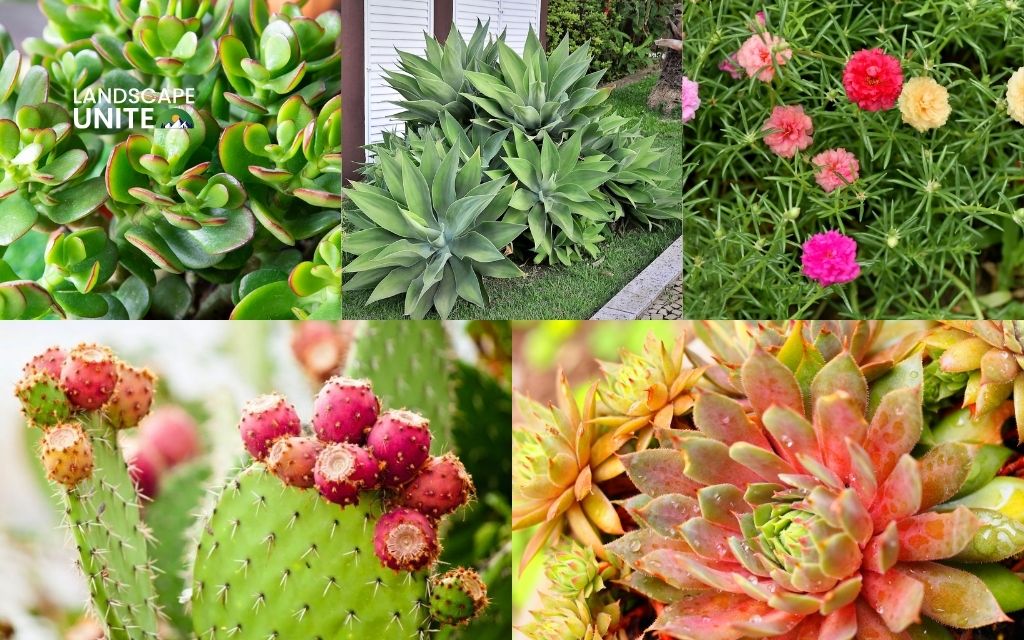
Why succulents are perfect for xeriscaping
The water-storing capabilities of succulents create multiple layers of conservation benefits.
During periods of adequate rainfall or irrigation, succulents absorb and store excess water in their tissues. This stored water sustains the plants through extended dry periods, reducing or eliminating the need for supplemental irrigation.
This storage capacity also contributes to garden resilience during drought conditions or water restrictions. While traditional landscapes may suffer or die during dry spells, succulent-based xeriscapes continue to thrive, maintaining their beauty and property value even under challenging conditions.
Additionally, the deep root systems of many succulents help improve soil structure and water infiltration, creating benefits that extend beyond individual plants to support overall landscape health and sustainability.
How to choose the best succulents for xeriscaping
Consider your region
Successful succulent selection begins with understanding your local climate conditions and choosing varieties that naturally thrive in your region. Southwest and desert climates offer ideal conditions for most succulents, with low humidity, abundant sunshine, and minimal rainfall.
Mediterranean climate regions, including much of California, provide excellent conditions for a wide range of succulent varieties. The mild, wet winters and dry summers mirror the natural habitat of many popular species.
Even in more challenging climates, cold-hardy succulents like Sempervivum and certain Sedum varieties can successfully overwinter, expanding xeriscaping possibilities for northern gardeners.
- Hot desert climates: Agave, Yucca, Opuntia thrive in 100°F+ heat
- Mediterranean climates: Most succulents work well with mild, wet winters
- Cold regions (Zone 3-6): Choose hardy varieties like Sempervivum, Sedum
Drought resistance and growth habits
While all succulents demonstrate some level of drought tolerance, the degree varies significantly among species.
True desert natives like Agave and Opuntia can survive on annual rainfall alone, while others may require occasional supplemental irrigation during establishment or extreme drought.
Growth habits also impact landscape design and maintenance requirements:
- Spreading varieties like Sedum create natural ground covers but may require occasional pruning to control expansion.
- Upright forms like Yucca provide vertical structure but need adequate spacing to accommodate mature size.
Consider the mature size and spread of selected varieties to ensure proper spacing and avoid overcrowding. Many succulents continue growing slowly for decades, gradually developing impressive specimens that serve as landscape anchors.

Designing for beauty and function
Successful xeriscape design combines succulents based on complementary characteristics including texture, color, and growth habits. Pair fine-textured varieties like Sempervivum with bold, architectural forms like Agave to create visual contrast and interest.
Color coordination enhances overall design impact. Blue-gray varieties like certain Echeveria complement warm-toned species, while plants with colorful leaf margins or seasonal color changes add dynamic elements to static compositions.
Strategic placement maximizes visual impact while meeting practical requirements. Use low-growing varieties for borders and ground covers, medium-height species for middle layers, and tall specimens as focal points or background elements. Container plantings allow for seasonal rearrangement and highlight special varieties.
If you need inspiration for your xeriscape garden, check out the following articles.
- 15 low-maintenance and easy xeriscaping ideas for beginners
- 30 stunning xeriscape ideas to transform your yard
How to care for xeriscape succulents
Even the best succulents for xeriscaping need proper care to thrive. Follow these proven techniques to ensure your water-wise garden flourishes with minimal effort.
Soil & drainage
The foundation of succulent success lies in proper soil preparation. Use a sandy or cactus-specific soil mix that allows water to drain quickly – succulents despise soggy roots.
If your native soil is heavy clay, amend generously with coarse sand, perlite, or pumice to improve drainage.
Ensure elevated beds or natural slopes for runoff, as standing water is the number one killer of these drought-adapted plants.
Watering schedule
Contrary to popular belief, succulents do need water, they just need it differently.
- Water deeply but infrequently, approximately once every 2 – 4 weeks. This encourages deep root growth and improves drought tolerance.
- Reduce watering significantly in winter to prevent rot when growth naturally slows.
- Always allow soil to dry completely between waterings.
Sunlight requirements
Most outdoor succulents for xeriscaping need 6+ hours of direct sunlight daily to maintain compact growth and vibrant colors.
However, in extremely hot regions (zones 9 – 10), provide afternoon shade to prevent sunburn, especially for more delicate varieties like Echeveria and Graptopetalum.
Morning sun with afternoon protection creates ideal conditions in desert climates.
Winter Protection
Protect your investment when temperatures drop. Move container succulents indoors or to protected areas before the first frost.
For in-ground plants, cover tender varieties with frost cloth when temperatures threaten to drop below freezing.
Cold-hardy varieties like Sempervivum and Agave parryi can withstand significant cold, but even these appreciate mulch protection in their first winter.
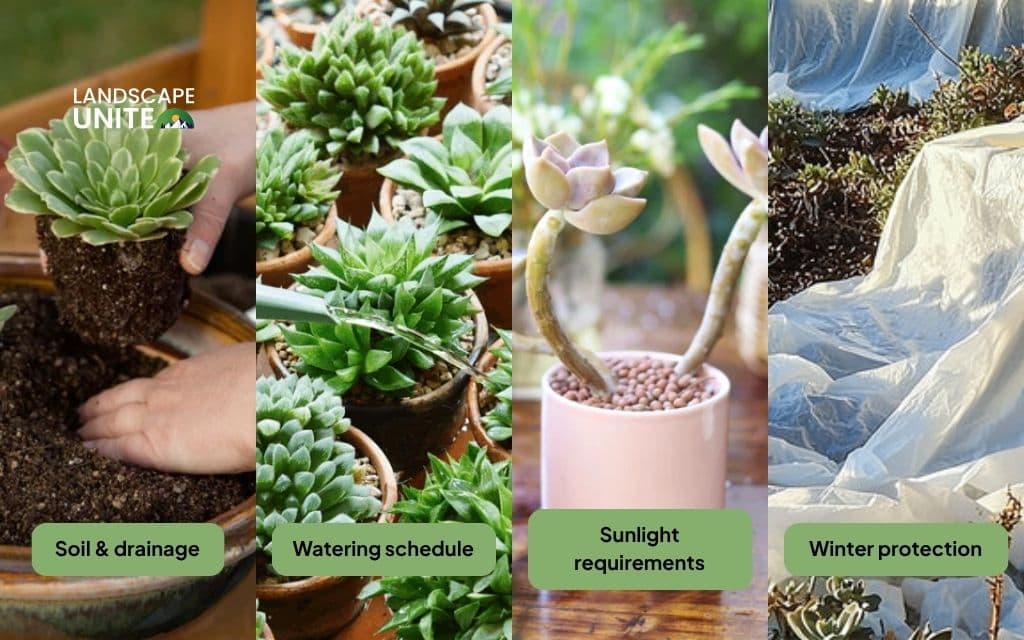
Conclusion
The best succulents for xeriscaping offer an unbeatable combination of water efficiency, low maintenance requirements, and stunning visual appeal.
Your next steps involve selecting varieties appropriate for your climate and design goals, preparing well-draining planting areas, and establishing proper watering routines during the establishment period.
Once established, your succulent xeriscape will reward you with years of low-maintenance beauty while contributing to water conservation efforts.
Transform your outdoor space into a water-wise paradise that thrives with minimal input while maximizing visual impact.
Discover more expert gardening guidance and design inspiration from our comprehensive resource library to elevate your xeriscaping skills and create the sustainable garden of your dreams.
Frequently asked questions (FAQs)
How do succulents help conserve water in xeriscaping?
Succulents conserve water through specialized anatomical adaptations including thick, waxy leaves that minimize evaporation, extensive root systems that efficiently capture available moisture, and tissue structures that store water for extended periods.
Can succulents survive in the shade?
While most succulents prefer full sun conditions, several varieties tolerate partial shade, including many Aloe species, Crassula varieties, and some Echeveria. However, succulent plants in shade typically require less water and may develop more elongated growth habits as they stretch toward available light.
What are the best succulents for desert gardens?
Desert gardens benefit most from native and adapted species including Agave, Yucca, Opuntia, and desert-adapted Aloe varieties. These plants naturally thrive in extreme heat, intense sunlight, and minimal rainfall conditions typical of true desert environments.
How often should I water my succulents?
You should deep water every 2-4 weeks during growing seasons, with reduced frequency during winter dormancy. However, watering frequency depends on climate, soil drainage, and seasonal conditions. The key principle is allowing soil to dry completely between waterings.
What are the best low-maintenance succulents for xeriscaping?
The most low-maintenance options include Sedum varieties, Sempervivum, established Agave plants, and native Opuntia species. These varieties rarely require pruning, fertilizing, or pest management once established, making them ideal for busy homeowners or remote landscape areas.
